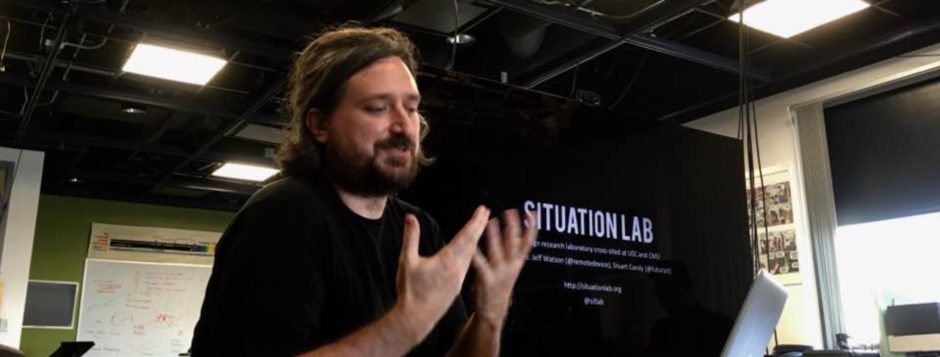[intro]Mela Kocher Lennstroem is a Swiss games researcher currently living in San Diego, where she conducts post-doctoral research on “the blurring of reality and fiction in digital media, especially in ARGs.” I caught up with Mela via Twitter and email after she co-presented (with Ken Eklund, Stephen Petrina, and PJ Rusnak) a “mini ARG” at the 2010 Digital Media and Learning Conference in La Jolla, California — an event I wish I’d attended, especially after talking to Mela about what happened during her session.[/intro]
First off, I noticed your dissertation, “Follow the Pixel Rabbit,” on your website. Even though I can’t read German, I found it interesting to flip through the pages. Speaking generally, what’s your dissertation about — and what does the Alice reference in the title mean?
I wrote my dissertation on storytelling in video games around 2002/2003. At that time game studies was still a pretty new thing at universities in Switzerland (and games not really accepted as a serious academic subject). With the reference to Alice in Wonderland I wanted to make the statement that digital games offer a magic, bizarre and wonderful world for the one who dares to enter. My dissertation is about different ways of storytelling and player engagement of video games, hyperfiction and interactive movies – latter being a genre that failed remarkably in its beginnings – just watch/play I’m Your Man!
Obviously you are engaged with a lot of different fields of inquiry, from game design to narratology to aesthetics. How did you end up deciding to study/make this kind of stuff? What path did you take to becoming a theorist-practitioner?
Besides frenetically playing Games & Watch as a child, I lead a pretty video game-free life until my roommate in college got me into Myst and Riven. I studied German literature at that point and was curious to test the traditional literary theory frameset on games – and luckily my professor was encouraging that. Writing a dissertation on the topic was a pretty natural step (since it was fun, challenging and exciting), and during that time I played lots of games and taught many game workshops for teachers and librarians. In the past years I’ve been getting more and more intrigued by ARGs and their vast potential for storytelling and blurring the lines between fiction and reality – so I was more than happy to have gotten a research grant to study, play and now even make ARGs in the USA for two years.
You recently appeared on a panel at the Digital Media and Learning conference entitled, “Storytellers, Storymakers and Learning by ARG.” As a part of the panel, you and your co-panelist, game designer Ken Eklund (World Without Oil), designed and ran a mini-ARG. What was the purpose of this game, and how did it work?
The conference theme was “Diversifying Participation”, and our team wanted to discuss ARGs & participatory learning. Since it would probably take an hour to explain what ARGs are (and people still wouldn’t get it!), it seemed more effective (and way more fun!) to have the audience engage in one first hand. The game plot went like this: One of the speakers (which ended up being me) got lost on campus and was not be able to show up for the session in time. While Ken explained this to the waiting conference attendees, he had a “stress-induced narcoleptic attack of 20 minutes” so the audience was completely left to themselves (while our other two team members, PJ Rusnak and Stephen Petrina, stayed incognito in the room for possible trouble shooting).
I wish I had been there. How many people ended up participating?
You should have! There were around 40 people in a quite tiny room so it was packed. It was amazing which strategies the participants came up with – they started a Facebook search, tried to sneak Ken’s phone from his sleeping hand, they tweeted me, tried to call and text me and physically went out on campus to search for me – unfortunately for them, in my fictional world my phone was malfunctioning and I could only send them pictures from my location via tweet to ping.fm. That constraint gave way to lots of creativity, though (as our PM team had hoped for), and the participants truly engaged in their storymaking efforts.
What kind of feedback did you get? How was the notion of “learning by ARG” understood by the assembled educators?
There was definitely excitement in the room during the game (I watched the video later on). Most of them immediately understood that it was a game, and got into play mode. My favorite reaction was the (failed) gamejack attempt of one man who offered to hold his own speech while they were waiting for the scheduled speaker. Another person doubted that I was truly lost but suggested that I might just need a bit of comforting to take up my role as speaker. Lovely!
Even from this short ARG performance, people saw the great potential ARGs bear for learning – via features like creativity, collaboration, common goals, instant player feedback, immersion, role play, problem-solving… Most attendants thought of the ARG as an inspiring experience during an academic conference stuffed with formal one-to-many presentations.
On a more meta level, how do participatory game constructs like storymaking ARGs complicate or extend your thinking on narrative in digital games? Are the categories of “story” and “game” collapsing into one another, or do the traditional boundaries still hold?
ARGs have a potential for storytelling and storymaking that video games do not have, because of the possibility for real time interaction with the puppet masters and the actual chance for the player (or the more believable illusion!) to influence the course of the game. Narrative adventure video games are in comparison to that so limited and often incoherent due to their closed programming. Of course, more open structured video games like GTA offer completely different ways of experiencing and creating a story as well which also extends beyond the realm of the screen, but ARGs just take this idea much further. But new options bear new problems, and ARGs rely on the puppet masters’ coherent and instant feedback and their fair choices – and on the collaboration of the fellow players.
To your second question: I’d rather keep the concepts of “story” and “game” apart for analytical reasons, even though they tend to overlap [in the case of] ARGs: [that is,] I can play by being part of the story or by trying to crack a code. I would say that ARGs make story playable, but they are more story than game – but then this also depends on what the player is looking for. I myself love to ‘stalk’ a character and get into the game through character interaction while others love to solve puzzles etc. – the more traditional game-aspects of an ARG.
What’s next for ARGs — and for your research in general?
I’m curious to see if ARGs will develop towards shorter, replayable and even payable game formats for wider audiences (and therefore blend with features of video games).
I myself got very intrigued by having experienced a challenging setting like the academic conference as a playground, and I hope to investigate further in that direction. I’m not a fan of serious games per se, but I do believe that “play” in general provides at its core some of the most valuable experiences for living and learning.
Thanks, Mela!



